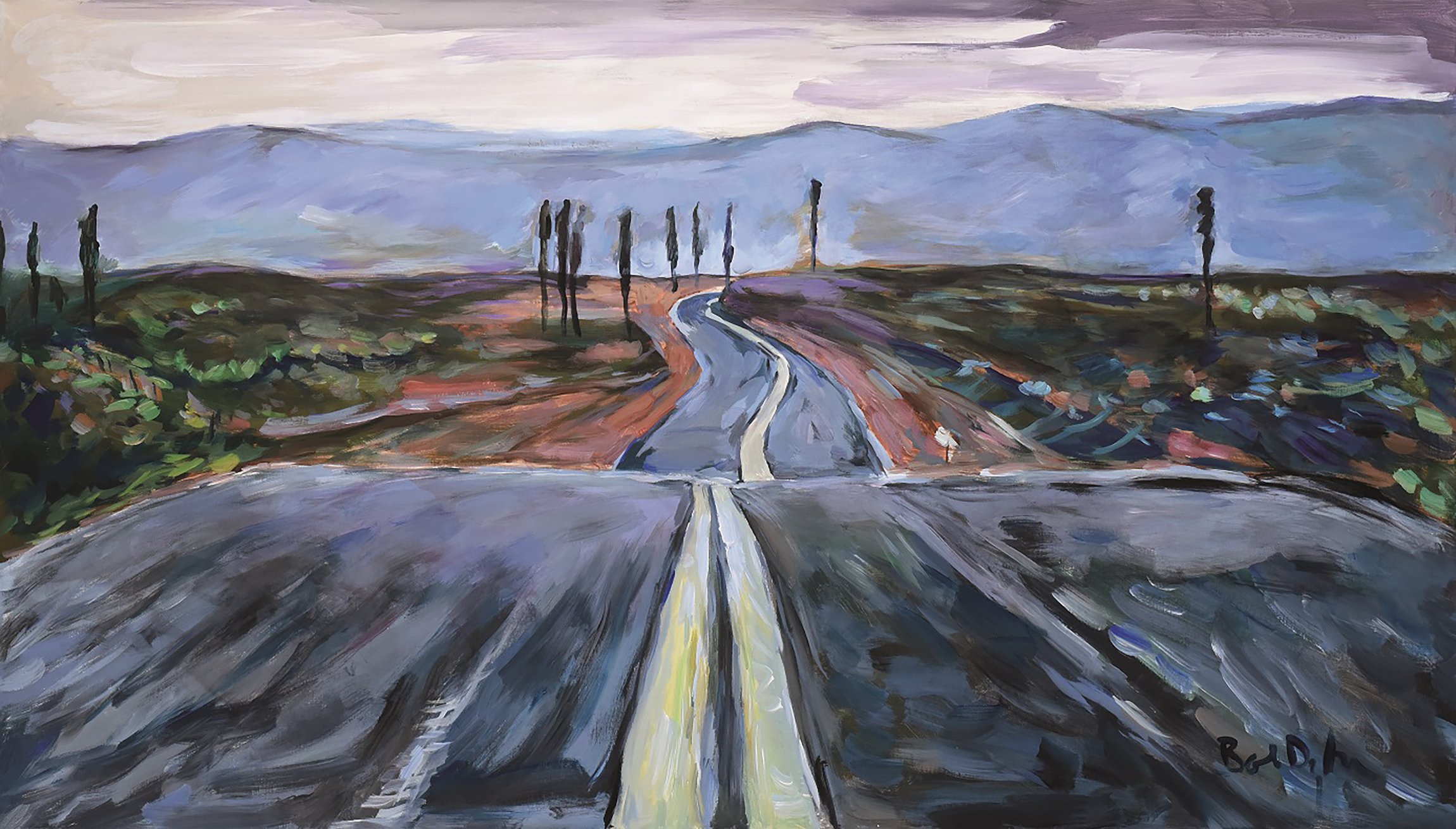
You can’t fault Bob Dylan for his vision. Over a career that has extended far beyond half a century, the musician has logged in song the social milieu, cultural tapestry, and very human experience of a country in constant flux. His visual art practice has been no less observant, and in recent years, has itself been drawing eyeballs with the touring exhibition “Retrospectrum.” So ample are its contents that Dylan’s first artist monograph has now arrived to survey its scope.
Released to coincide with the show’s European debut at the MAXXI in Rome, Italy, the book, also titled Retrospectrum, brings together more than 100 artworks that Dylan has created over the past six decades. It includes his early ink sketches, silkscreen collages, iron sculptures, and acrylic paintings—all of them bearing out his eye for haunting detail in everyday moments.
(Noticeably absent from the book’s array of works is Dylan’s early and most visible self-portrait, printed on the cover of his 1970 album Self-Portrait, which was critically panned.)
“Dylan’s works of visual art are a testament to his creative breadth and depth,” Shai Baitel, the artistic director of Modern Art Museum, Shanghai, who edited the volume, told Artnet News. “We sense that, like in his songwriting, his art gives us a distinct perspective of and from Dylan, offering at once a representation of many moments and sentiments as well as a reflection of society—of us.”
Bob Dylan. Photo: William Claxton.
Indeed, for a songwriter who has observed the party crowd of New York City as well as a country stream in Woodstock; who has detailed the dissolution of a marriage and a spiritual awakening; who has sung of a socialite in a leopard-skin pillbox hat as he has of a Black man falsely convicted of murder, Dylan would take a similarly perceptive view on canvas.
Where his early works on paper simply saw him doodle his immediate surroundings—“the typewriter, a crucifix, a rose, pencils and knives and pins,” according to him—his more mature works would capture in earthy color scenes from his life on the road and his travels in New Orleans and Asia. There’s a bicycle parked on a pavement, a motel sign, a theater marquee, and the endless open road. This distillation of moments further emerges in his most recent “Deep Focus” series of paintings, which draws on scenes from movies.
Bob Dylan, Marlboro Man (2021). Photo: © 2021 Bob Dylan.
In Baitel’s view, “Dylan is a keen observer, a historian, capturing a moment in time, in all its dimensions and meanings.”
But for Richard Prince, who penned one of the essay’s in Retrospectrum, one does not necessarily have to read meaning into Dylan’s visual art for it to be “genius.” Dylan’s straightforward, representational paintings, Prince wrote, are “workmanlike and they do their job. They’re not trying to be something they’re not.”
Which does hark back to Dylan’s roots in the folk tradition, wherein plain-speaking narratives invite the listener’s myriad interpretations (what, after all, could be the answer “blowin’ in the wind”?). And for what it’s worth, Dylan has described the purpose of his artwork as “plain, non-experimental, or exploratory.”
Bob Dylan, Spike Chain Ring Wall Hanging (2016). Photo: © 2016 Bob Dylan.
And for Dylan fans seeking out his greatest hits, his “Mondo Scripto” group of works might stand out with fresh insight into his compositions. As presented in Retrospectrum, the series juxtaposes Dylan’s handwritten lyrics with his graphite drawings, completed in 2018, each illustrating a scene or theme from its respective song.
“Like a Rolling Stone” is accompanied by a sketch of a slumping Napoleon, echoing the song’s lyric of a “Napoleon in rags.” An image of a woman looking out her window depicts the lover he’s jilted in “Don’t Think Twice, It’s All Right,” just as an illustration of a man chowing down a taco fittingly captures the tone of “Workingman’s Blues #2.”
As Baitel puts it, the series could make for “a fascinating discovery for those who hadn’t been familiar with his visual work.” More so, he added: “The series offers an opportunity to witness the crystallization of Dylan’s complex creativity in different mediums.”
Bob Dylan, Dark Clouds (2021). Photo: © 2021 Bob Dylan.
Dylan himself has not been particularly voluble about his visual art, but quotes scattered throughout Retrospectrum offer windows into how even his most spontaneous sketch “purified the experience of my eye.”
“Seeing many of my works years after I completed them is a fascinating experience,” he said. “I don’t really associate them with any particular time or place or state of mind, but view them as part of a long arc; a continuing of the way we go forth in the world and the way our perceptions are shaped and altered by life.”
See more images from the book below.
Bob Dylan, Vista from Balcony (2009). Photo: © 2009 Bob Dylan.
Bob Dylan, Double Gate (Livery) (2017). Photo: © 2017 Bob Dylan.
Bob Dylan, Elevated Train (2020). Photo: © 2020 Bob Dylan.
Bob Dylan, Red Sunset (2019). Photo: © 2019 Bob Dylan.
Bob Dylan, Gentlemen’s Club (2021). Photo: © 2021 Bob Dylan.
Bob Dylan: Retrospectrum, edited by Shai Baitel, is published by Skira Editore. “Bob Dylan. Retrospectrum” is on view at MAXXI, Via Guido Reni, 4 A, Rome, Italy, through April 30.